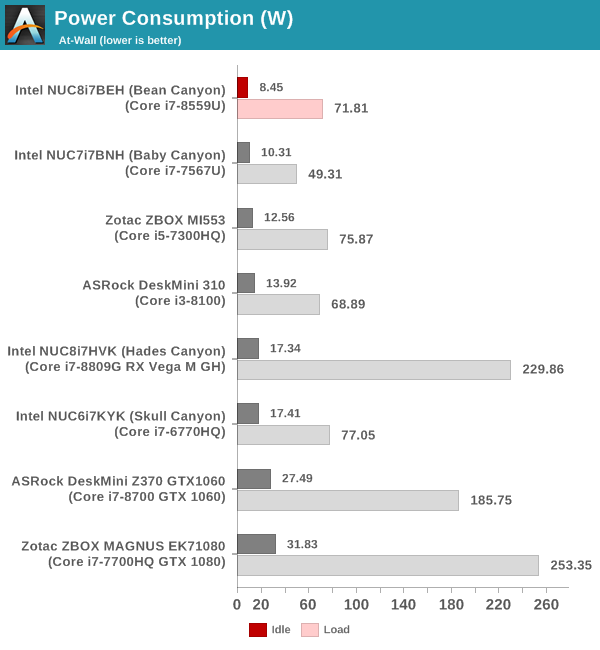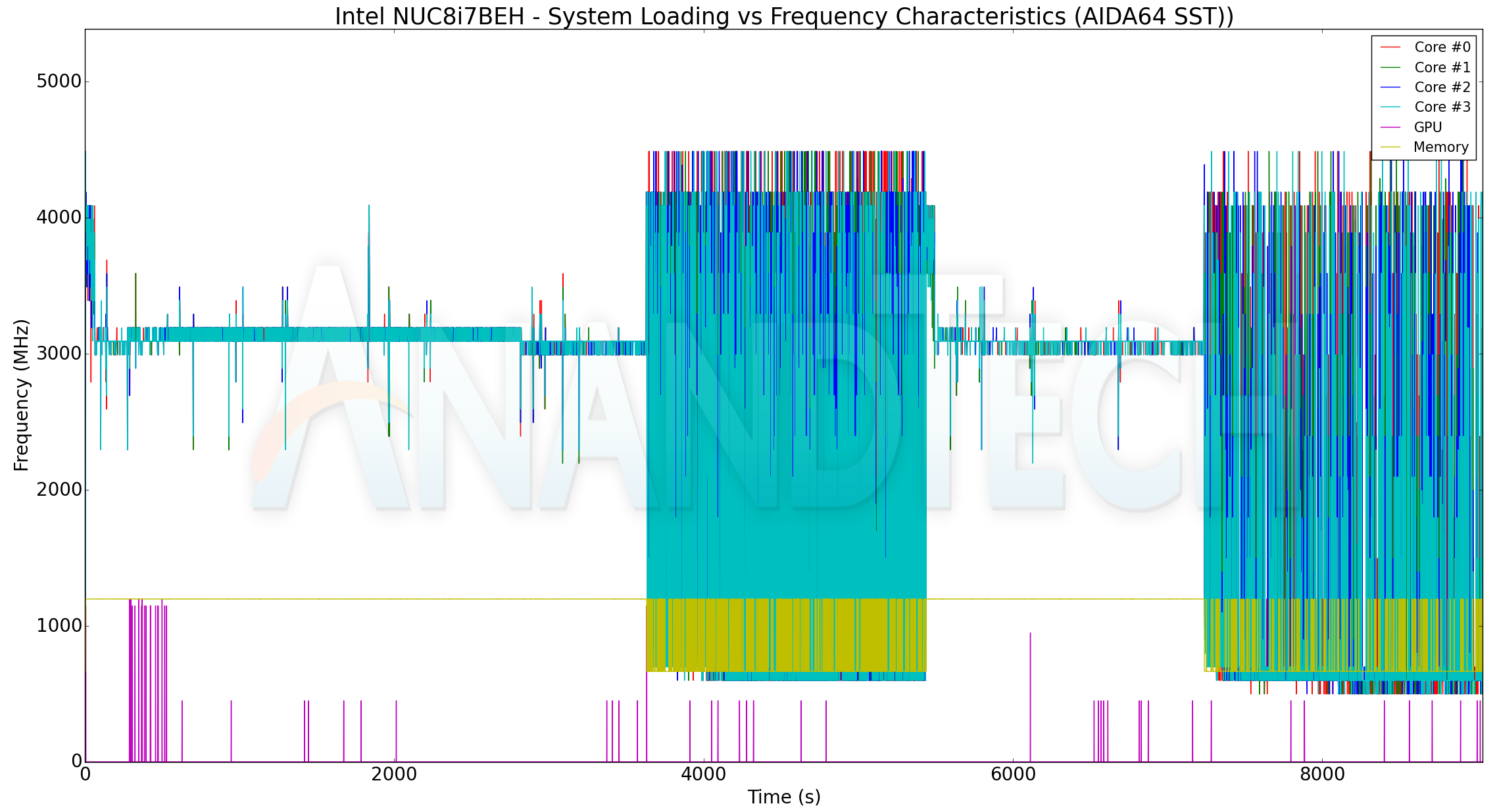Intel's Bean Canyon (NUC8i7BEH) Coffee Lake NUC Review - Ticking the Right Boxes
by Ganesh T S on April 3, 2019 8:00 AM EST- Posted in
- Systems
- Intel
- NUC
- UCFF
- Thunderbolt 3
- Cannon Point
- Coffee Lake-U
Miscellaneous Aspects
Prior to the business end of the review, we take a look at the power consumption numbers and thermal performance of the NUC9i7BEH. The power consumption at the wall was measured with a 4K display being driven through the HDMI port. In the graphs below, we compare the idle and load power of the Intel NUC8i7BEH (Bean Canyon) with other low power PCs evaluated before. For load power consumption, we ran the AIDA64 System Stability Test with various stress components, as well as our custom Prime95 + Furmark stress test, and noted the maximum sustained power consumption at the wall.

The Bean Canyon NUC has low idle power (best of the lot), but, the higher load power reflects the capabilities of the Core i7-8559U and its 28W TDP.
Our thermal stress routine starts with the system at idle, followed by four stages of different system loading profiles using the AIDA64 System Stability Test (each of 30 minutes duration). In the first stage, we stress the CPU, caches and RAM. In the second stage, we add the GPU to the above list. In the third stage, we stress the GPU standalone. In the final stage, we stress all the system components (including the disks). Beyond this, we leave the unit idle in order to determine how quickly the various temperatures in the system can come back to normal idling range. The various clocks, temperatures and power consumption numbers for the system during the above routine are presented in the graphs below.
| Intel NUC8i7BEH (Bean Canyon) System Loading with the AIDA64 System Stability Test | |||

The system is able to sustain a 28W CPU package power with the core temperature around 90C. The fan is quite noisy in this state, as one may expect. The SSD temperatures are a bit worrisome, pointing to a lack of airflow that could help cool down high-performance NVMe SSDs.
Our custom stress test involves running Prime95 in maximum power consumption mode for 30 minutes, followed by both Prime95 and Furmark for 30 minutes. Beyond this, the Prime95 load is taken off, and Furmark alone is left to run for aother 30 minutes. After this, we let the system idle and cool down. The various clocks, temperatures and power consumption numbers for the system during the above routine are presented in the graphs below.
| Intel NUC8i7BEH (Bean Canyon) System Loading with Prime95 and Furmark | |||

Our custom stress test manages to sustain a 30W package power while keeping the cores at less than 85C. There is no stress on the SSDs to worry about in this test.
Concluding Remarks
The NUC8i7BEH continues Intel's tried and tested incremental improvements scheme for their mid-range NUC line. The move to CFL-U enables a couple of attractive features - high-performance external I/O with an all USB 3.1 Gen 2 configuration, and a 1.73 Gbps 802.11ac 2x2 WLAN chipset. The Bean Canyon NUCs also retain the Thunderbolt 3 Type-C port (introduced to the mid-range NUC family in the NUC7 series) for virtually limitless expansion options. With Thunderbolt 3 having matured, and the availability of various eGFX enclosures, the absence of a discrete GPU in the NUC8i7BEH will hardly be felt. In fact, we had evaluated Powercolor's Gaming Station using the NUC8i7BEH as one of the test platforms, and came away impressed. On the whole, it is almost impossible to find issues with the Bean Canyon NUC from a performance and feature-set perspective.
The NUC8i7BEH does have scope for improvement, though. The platform itself is excellent. However, the fan noise / thermal performance is disappointing. It is no doubt challenging to keep a 28W TDP SiP properly cooled in a UCFF machine. Eschewing the UCFF form-factor, and going with a slightly larger case with better airflow could help sustain the higher performance levels of the platform for a longer time. On the feature-set side, Intel would do well to bring dual Thunderbolt 3 ports to their mid-range lineup. Perhaps an additional Thunderbolt 3 controller directly attached to the CPU's PCIe lanes could make the platform look even more attractive. All said, these suggestions should take nothing away from the fact that the NUC8i7BEH is a compact powerhouse. It ticks all the right boxes for multiple use-cases ranging from productivity and office work to HTPC applications.











81 Comments
View All Comments
StevoLincolnite - Wednesday, April 3, 2019 - link
The only thing that hinders me from jumping onto one of these... Is the Intel Decelerator Graphics.AMD needs to apply some much needed competition in the NUC space I think!
notashill - Wednesday, April 3, 2019 - link
Check out the ASRock DeskMini A300 or HP EliteDesk 705, not *quite* as small as the NUC but fairly close and use Ryzen APUs.Irata - Wednesday, April 3, 2019 - link
The AT review of it should be due in a week or two according to Ganesh (he added this as a comment under the Intel based A310).Targon - Wednesday, April 3, 2019 - link
Zotac offers AMD based solutions. I'd wait for the 7nm AMD chips if you can wait, since they will be better for very small machines.sor - Wednesday, April 3, 2019 - link
Zotac is dead to me after teasing the MA551 (the only potential ryzen competitor to the NUC) for over a year and then canceling it. I’m not aware of any Zotac competitors at this level that have a modern AMD APU.I was on the verge of buying one of these NUCs but at the last moment the Asrock A300W came out, which is a much better deal. Far better graphics and cheaper.
Irata - Thursday, April 4, 2019 - link
I think it's good to remember companies who have let us down in the past when making purchase decisions.mikato - Thursday, April 4, 2019 - link
Yes, I kept waiting for that also. I didn't realize they formally cancelled it, I just never heard anything and when I searched periodically I just found other people wondering the same thing.sor - Thursday, April 4, 2019 - link
I came across this thread. I assume “Z_staff” speaks for Zotac.https://www.reddit.com/r/ZOTAC/comments/9af6by/zot...
mikato - Friday, May 3, 2019 - link
Ah. Well good to know finally I guess :/jordanclock - Wednesday, April 3, 2019 - link
They get the Hades Canyon NUC with the Vega M GH? You get a fast Intel CPU and a noticeable bump in GPU performance. Granted, you're also doubling the power usage.